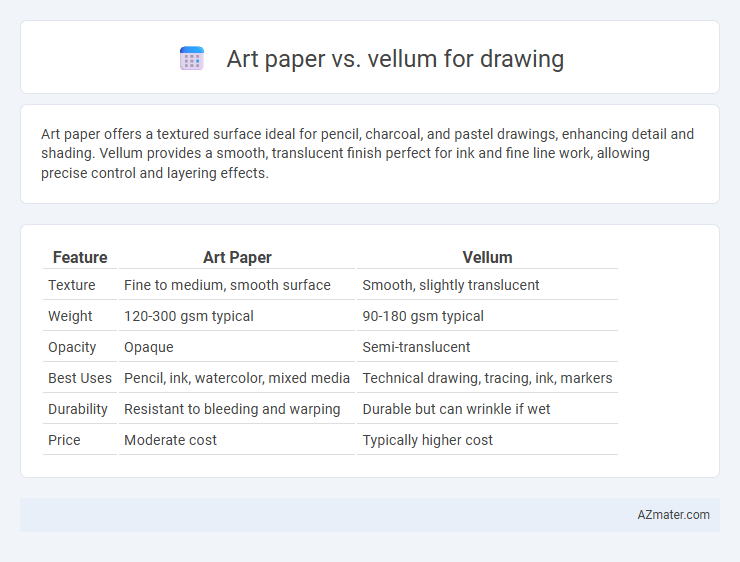Art paper offers a textured surface ideal for pencil, charcoal, and pastel drawings, enhancing detail and shading. Vellum provides a smooth, translucent finish perfect for ink and fine line work, allowing precise control and layering effects.
Table of Comparison
| Feature | Art Paper | Vellum |
|---|---|---|
| Texture | Fine to medium, smooth surface | Smooth, slightly translucent |
| Weight | 120-300 gsm typical | 90-180 gsm typical |
| Opacity | Opaque | Semi-translucent |
| Best Uses | Pencil, ink, watercolor, mixed media | Technical drawing, tracing, ink, markers |
| Durability | Resistant to bleeding and warping | Durable but can wrinkle if wet |
| Price | Moderate cost | Typically higher cost |
Introduction to Art Paper and Vellum
Art paper and vellum serve distinct purposes in drawing, each offering unique textures and durability. Art paper, often made from cotton or wood pulp, features a rough or smooth surface ideal for graphite, charcoal, or ink, providing excellent ink absorption. Vellum, a translucent and smooth material traditionally made from calfskin but now available as synthetic, is favored for precision work and layering due to its durability and ability to handle fine details without bleed-through.
Defining Art Paper: Characteristics and Types
Art paper, designed specifically for artistic purposes, features a textured surface that enhances pencil, charcoal, and pastel adhesion, with common types including cold-pressed, hot-pressed, and rough varieties tailored to different drawing techniques. Vellum, a translucent, smooth paper made from high-quality cotton or cellulose, offers durability and a unique finish ideal for detailed ink or graphite work but lacks the absorbency of traditional art papers. Choosing between art paper and vellum depends on the desired texture, medium compatibility, and the artwork's final presentation requirements.
What is Vellum? Key Features and Origins
Vellum is a high-quality, translucent drawing surface traditionally made from calfskin, prized for its smooth texture and durability, making it ideal for detailed artwork and architectural drawings. Originating from medieval Europe, vellum was historically used for manuscripts and important documents due to its longevity and fine finish. Modern vellum is often a synthetic paper tailored to mimic these original properties, providing artists with a stable, rescaled option compared to standard art paper that lacks vellum's translucency and archival strength.
Surface Texture Comparison: Smoothness vs Tooth
Art paper typically features a textured surface known as "tooth," which enhances graphite and charcoal adherence, making it ideal for detailed or layered drawings. Vellum, by contrast, offers an exceptionally smooth surface with minimal tooth, allowing for precise ink work and clean lines but less grip for dry media. The choice between art paper and vellum depends on the desired effect: textured paper provides depth and shading capabilities, while vellum supports sharp, controlled strokes.
Performance with Different Drawing Mediums
Art paper offers a textured surface that enhances charcoal, graphite, and pastel application by providing excellent tooth for medium adhesion, resulting in rich, detailed drawings. Vellum's smooth, translucent quality excels with ink, markers, and fine liners, allowing precise, clean lines and minimal bleeding. The choice between art paper and vellum largely depends on the desired medium performance, with art paper better suited for dry, powdery mediums and vellum optimal for wet, fluid inks.
Transparency: When Does It Matter?
Transparency in drawing paper significantly impacts the choice between art paper and vellum, especially for layering techniques or lightbox tracing. Vellum offers a high degree of translucency, allowing artists to see underlying sketches and guides clearly, making it ideal for precise, multi-layered compositions. In contrast, traditional art paper is usually opaque, which limits its use in applications requiring visibility through the surface, thus affecting workflow and technique decisions.
Durability and Archival Quality
Art paper offers moderate durability with a textured surface that supports various drawing mediums but may yellow or degrade over time if not acid-free. Vellum, made from translucent synthetic materials, provides superior durability and archival quality, resisting yellowing, moisture, and wear, making it ideal for long-lasting artwork preservation. Choosing vellum ensures archival stability and enhanced robustness compared to traditional art paper.
Cost and Availability Considerations
Art paper generally offers a more cost-effective option for drawing projects, with a wide range of prices and easy availability at art supply stores. Vellum, known for its smooth texture and translucency, tends to be pricier and less accessible, often requiring specialty purchase from professional art suppliers. Artists seeking budget-friendly materials typically prefer art paper, while those needing high-quality, unique surfaces might opt for vellum despite its higher cost and limited availability.
Choosing the Right Paper for Your Artistic Needs
Choosing between art paper and vellum depends on your drawing medium and desired texture; art paper offers varied textures and thickness suited for graphite, charcoal, and ink, providing ample tooth for detailed work. Vellum's smooth, translucent surface is ideal for precise line work, tracing, and layering, often favored in architectural or technical drawings for its durability and clean finish. Assess the interaction of your tools with the paper's texture and opacity to select the best substrate that enhances your artistic expression and medium performance.
Conclusion: Art Paper or Vellum—Which Should You Choose?
Art paper offers textured surfaces ideal for traditional media like charcoal and pastels, providing rich color absorption and durability. Vellum features a smooth, translucent quality perfect for detailed work with ink or markers, enabling precise lines and layering effects. Choosing between art paper and vellum depends on the drawing medium and desired artistic effect, with art paper suited for expressive textures and vellum favored for clarity and fine detail.

Infographic: Art paper vs Vellum for Drawing
 azmater.com
azmater.com